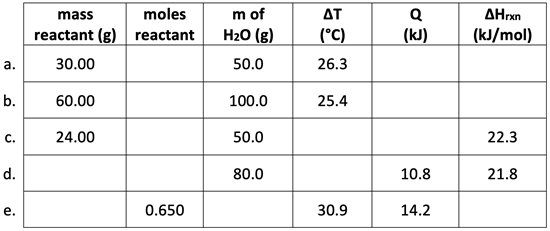Measuring the Quantity of Heat - Questions
The Measuring the Quantity of Heat Concept Builder is comprised of 16 multi-part, numerical questions spread across three difficulty levels. Students will receive one question for each difficulty level. Questions involve either the completion of a sentence (Apprentice Level) or the completion of a table (Master and Wizard Levels). The Concept Builder is coded to select at random a question for each level.
The three Difficulty Levels in this Concept Builder differ only in terms of the number of blanks that must be filled and the complexity of the given numbers. Here is the breakdown of the levels:
- Apprentice Difficulty Level: Questions 1-4 ... Students complete five sentences by providing a numerical value for a blank bu using the Q=m•C•∆T equation.
- Master Difficulty Level: Questions 5-10 ... Students complete a five row table relating Q, m, ∆T, Ti, and Tf. There are two blanks in each row.
- Wizard Difficulty Level: Questions 11-16 ... Students complete a five row table associated with the use of calorimetry to determine the heat of reaction in kJ/mol. There are three blanks in each row.
The questions from each group are shown below. Teachers are encouraged to view the questions in order to judge which difficulty levels are most appropriate for their classes. Alternatively, teachers can do the
Concept Builder to gain a feel for the student experience..
The Physics Classroom grants teachers and other users the right to print these questions for private use. Users are also granted the right to copy the text and modify it for their own use. However, this document should not be uploaded to other servers for distribution to and/or display by others. The Physics Classroom website should remain the only website or server from which the document is distributed or displayed. We also provide a PDF that teachers can use under the same conditions. We have included a link to the PDF near the bottom of this page.
Measuring the Quantity of Heat
Activity 1: Apprentice Difficulty Level
Question 1
In an exothermic process, a quantity of heat (Q) is released by a system, causing a change in temperature (∆T) of the surroundings. The surroundings consist of a mass (m) of water. The release of ...
a. ... 4.18 J of heat causes 1.00 g of H2O to have a ∆T of __________ °C.
b. ... 41.8 J of heat causes 5.00 g of H2O to have a ∆T of __________ °C.
c. ... 418 J of heat causes __________ g of H2O to have a ∆T of 2.50°C.
d. ... __________ J of heat causes 50.0 g of H2O to have a ∆T of 8.00°C.
e. ... 2400 J of heat causes 78.5 g of H2O to have a ∆T of __________ °C.
Question 2
In an exothermic process, a quantity of heat (Q) is released by a system, causing a change in temperature (∆T) of the surroundings. The surroundings consist of a mass (m) of water. The release of ...
a. ... 4.18 J of heat causes 1.00 g of H2O to have a ∆T of __________ °C.
b. ... 41.8 J of heat causes 2.00 g of H2O to have a ∆T of __________ °C.
c. ... 418 J of heat causes __________ g of H2O to have a ∆T of 4.00°C.
d. ... __________ J of heat causes 100.0 g of H2O to have a ∆T of 8.00°C.
e. ... 2800 J of heat causes 61.5 g of H2O to have a ∆T of __________ °C.
Question 3
In an exothermic process, a quantity of heat (Q) is released by a system, causing a change in temperature (∆T) of the surroundings. The surroundings consist of a mass (m) of water. The release of ...
a. ... 4.18 J of heat causes 1.00 g of H2O to have a ∆T of __________ °C.
b. ... 41.8 J of heat causes 4.00 g of H2O to have a ∆T of __________ °C.
c. ... 418 J of heat causes __________ g of H2O to have a ∆T of 2.00°C.
d. ... __________ J of heat causes 25.0 g of H2O to have a ∆T of 8.00°C.
e. ... 3200 J of heat causes 82.4 g of H2O to have a ∆T of __________ °C.
Question 4
In an exothermic process, a quantity of heat (Q) is released by a system, causing a change in temperature (∆T) of the surroundings. The surroundings consist of a mass (m) of water. The release of ...
a. ... 4.18 J of heat causes 1.00 g of H2O to have a ∆T of __________ °C.
b. ... 41.8 J of heat causes 2.50 g of H2O to have a ∆T of __________ °C.
c. ... 418 J of heat causes __________ g of H2O to have a ∆T of 5.00°C.
d. ... __________ J of heat causes 20.0 g of H2O to have a ∆T of 8.00°C.
e. ... 4600 J of heat causes 56.9 g of H2O to have a ∆T of __________ °C.
Activity 2: Master Difficulty Level
Question 5
An exothermic reaction causes Q J of heat to release to the surrounding m g of water at a temperature of Ti °C, causing it to increase its temperature by ∆T°C to a final temperature of Tf°C.
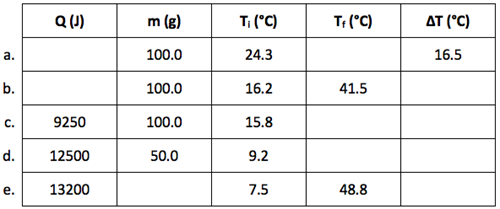
Question 6
An exothermic reaction causes Q J of heat to release to the surrounding m g of water at a temperature of Ti °C, causing it to increase its temperature by ∆T°C to a final temperature of Tf°C.
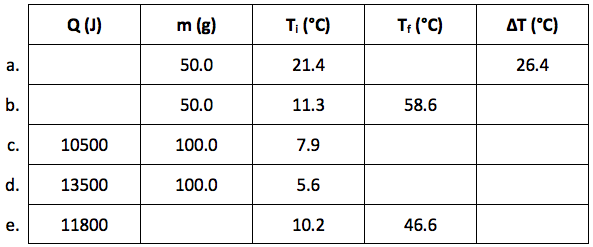
Question 7
An exothermic reaction causes Q J of heat to release to the surrounding m g of water at a temperature of Ti °C, causing it to increase its temperature by ∆T°C to a final temperature of Tf°C.
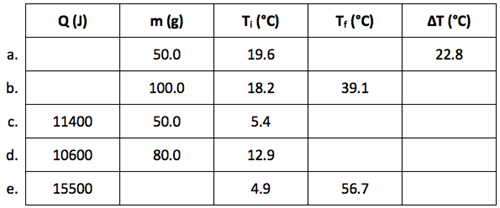
Question 8
An exothermic reaction causes Q J of heat to release to the surrounding m g of water at a temperature of Ti °C, causing it to increase its temperature by ∆T°C to a final temperature of Tf°C.
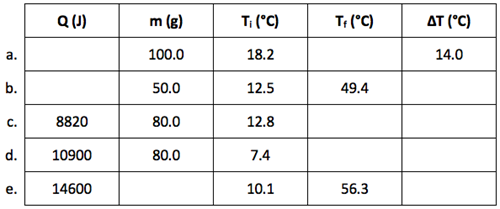
Question 9
An exothermic reaction causes Q J of heat to release to the surrounding m g of water at a temperature of Ti °C, causing it to increase its temperature by ∆T°C to a final temperature of Tf°C.
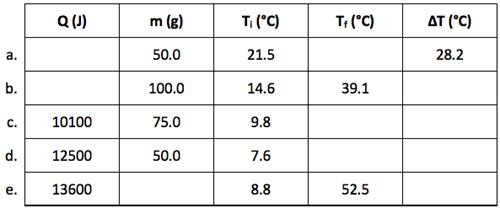
Question 10
An exothermic reaction causes Q J of heat to release to the surrounding m g of water at a temperature of Ti °C, causing it to increase its temperature by ∆T°C to a final temperature of Tf°C.

Activity 3; Wizard Difficulty Level
Question 11
In an effort to determine the heat of reaction (∆Hrxn), X grams of a reactant (molar mass = 40.00 g/mol) react, generating Q< kJ of heat. This causes m g of H2O in a calorimeter to increase its temperature by ∆T °C.
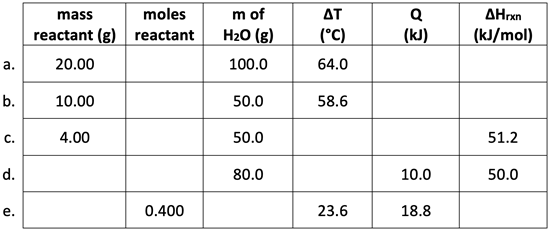
Question 12
In an effort to determine the heat of reaction (∆Hrxn), X grams of a reactant (molar mass = 40.00 g/mol) react, generating Q kJ of heat. This causes m g of H2O in a calorimeter to increase its temperature by ∆T °C.
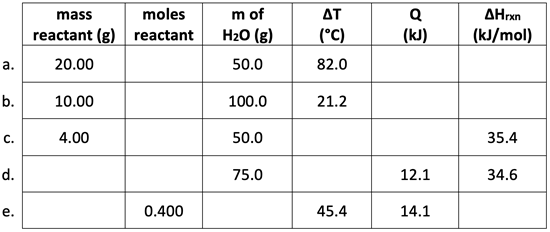
Question 13
In an effort to determine the heat of reaction (∆Hrxn), X grams of a reactant (molar mass = 80.00 g/mol) react, generating Q kJ of heat. This causes m g of H2O in a calorimeter to increase its temperature by ∆T °C.
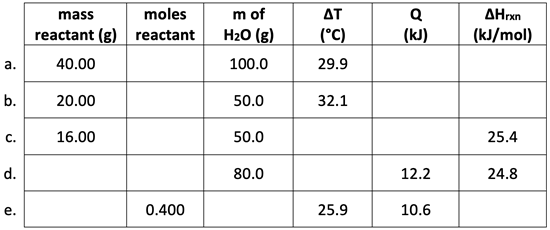
Question 14
In an effort to determine the heat of reaction (∆Hrxn), X grams of a reactant (molar mass = 80.00 g/mol) react, generating Q kJ of heat. This causes m g of H2O in a calorimeter to increase its temperature by ∆T °C.
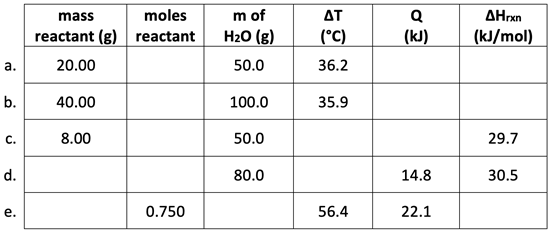
Question 15
In an effort to determine the heat of reaction (∆Hrxn), X grams of a reactant (molar mass = 120.00 g/mol) react, generating Q kJ of heat. This causes m g of H2O in a calorimeter to increase its temperature by ∆T °C.
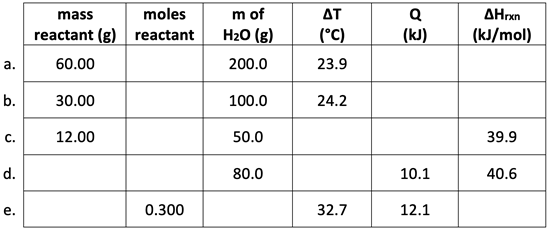
Question 16
In an effort to determine the heat of reaction (∆Hrxn), X grams of a reactant (molar mass = 120.00 g/mol) react, generating Q kJ of heat. This causes m g of H2O in a calorimeter to increase its temperature by ∆T °C.
